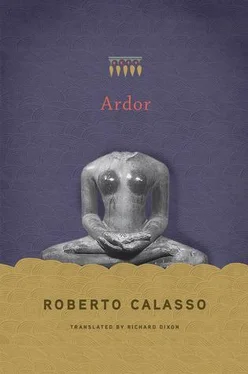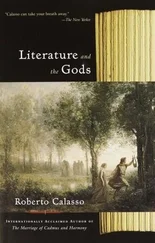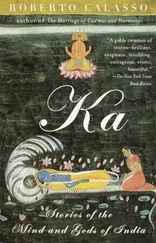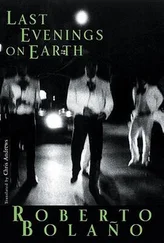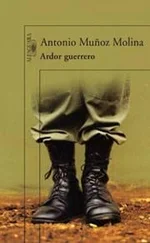* * *
“The life of sacrifice is therefore an infinite series of deaths and births,” wrote Sylvain Lévi. And so will be, in the first place, the initiation that is implicit in the sacrifice. To celebrate a sacrifice, the sacrificer must first be consecrated. And the consecration is a form of sacrifice — an endless circle on which everything turns. But for the initiand, more than for the others taking part in the ritual, birth and death must be as literal as possible. This is what distinguishes the initiand. During one part of the ceremony he will be the one who is still unborn: “He then wraps his head. For he who is consecrated becomes an embryo; and embryos are enveloped by the amniotic fluid and by the outer membrane; so he covers his head.” The veiled head, which we come across in Greek initiations and for which the texts give us no convincing justification, is explained here in a few brief words: the initiand, he who is consecrated, is an embryo — and the primary characteristic of an embryo is that of being hidden, veiled by a membrane. The turban therefore recalls that state of concealment, that of the initiand as an embryo, in the same way as its shape suggests Vāc’s womb torn open by Indra.
Of course, for the initiand to be literally an embryo raises certain difficulties, which might seem frivolous, like many other details of the ritual. For example: what does he do if, during the ceremony, he feels an itch? The rules are very strict: “He shall not scratch with a splinter of wood or with a fingernail. For he who is consecrated becomes an embryo: and if an embryo is scratched with a wooden splinter or a fingernail, the amniotic fluid could escape and he would die. Thereafter the consecrated one might suffer from itchiness; and his offspring might also be born with itchiness. Now the womb does not damage the embryo, and since the horn of the black antelope is the womb, it does not damage it; so the consecrated one should scratch himself with the horn of the black antelope and with nothing other than the horn of the black antelope.” The pictures conjured up by the rite are never just metaphors, in the sense of a lame literary device. They are invisible presences and at the same time are to be understood in a strict literal sense. If the consecrated one becomes an embryo, this must determine his behavior even at the most casual, unexpected, and insignificant moment: for example, when he feels an itch. And so we discover the subtle answer of the womb, which, with motherly concern, soothes the embryo within it. But how? With the horn of a black antelope, which, contrary to all evidence and appearance, is declared to be the womb. And so, the consecrated one scratches himself with the horn of a black antelope during the ceremony.
When the initiand is finally born, who is his father? The new birth that takes place through initiation makes it possible to escape the old worry of pater semper incertus. The father will now be one alone — and is neuter: brahman. And brahman , whatever it might be, is an intrinsic presence in the sacrifice, so that it could be said that “only he who is born from brahman is truly born,” but at the same time that “he who is born from the sacrifice is born from brahman. ” Beyond this acquired paternity, anyone might also be the child or the descendant of one of those Rakṣas who wandered the land and went “hunting for women,” like the angels in Genesis copulating with the daughters of men.
* * *
The night before the ceremony in which a person kindles his fires with the agnyādheya ritual is a most delicate moment. Until then he was a “mere man”—and what he did was unimportant. But now, if he wants to start building a relationship with the gods, the ritualists suggest he should remain awake through the night. And here lies the crucial point. What is the prime characteristic of the gods that we can emulate? Not power: ours will always be limited. Not immortality: we don’t have it — at most we may fool ourselves into thinking we have gained temporary immortality, after long practice. But it’s an immortality that gradually crumbles away, like every conquest gained by merit. Not knowledge, because it is far inferior to that of the gods: we don’t even know the mind of our neighbor, while “the gods know the minds of men.” So then, what? The pure fact of consciousness: of being awake. “The gods are awake”: moving closer to the gods means being awake. Not performing good works, not pleasing the gods with homage and offerings. Simply being awake. This is what enables anyone to become “more divine, more calm, more ardent,” in other words, richer in tapas. And was it not tapas that had enabled the gods to become gods? By isolating the pure fact of being awake and giving it supremacy over everything else, the ritualists made known their particular view with the utmost clarity. Everything could be traced back to this. And everything else could be eliminated, except this.
Becoming divine was not an ultimate experience reserved for the mystics: it was instead the experience of anyone who enters the sacrificial ceremony, immediately after having been consecrated: “He who is consecrated moves toward the gods; he becomes one of the divinities.” This is the passage to which Henri Hubert and Marcel Mauss refer when they describe entering the sacrifice as follows: “All that touches the gods must be divine; the sacrificer is obliged to become a god himself to be able to act over them.” Hidden in a hut built purposefully to keep him apart from the human world, shaved, washed, oiled, dressed in white linen and covered by a black antelope skin, the “consecrated one,” dīkṣita , gradually transformed into a divine embryo. He was made to move back and forth around the fire like the fetus kicking in the uterus. As always, the ritualists note the most subtle details: it is essential that the consecrated one holds his fists clenched. But not out of anger or despair. With that gesture he tries to seize the sacrifice. At that moment he says: “With the mind I take hold of the sacrifice.” It must be like this, because the sacrifice is invisible, like the gods: “The sacrifice is not visibly taken hold of, in fact, like this stick or a garment, but invisible are the gods, invisible the sacrifice.” Every event will be accurately described only if the description includes two parts: the visible and the invisible. And so the correct moment to unclench the fists is indicated with precision. Then the fetus “is born to divine existence, it is god.”
But even though the consecrated one, during the sacrificial journey, gradually moved closer to the gods, there still remained a vast distance. Revealed above all by one fact: the gods do not sleep, men are not granted sleeplessness. This, ironically, is enough to thwart human claims: not only do you have to die, but you are also unable to avoid sleep. And this again is why wakefulness was the highest good, the moment of greatest proximity to divine life. Otherwise, in ordinary life, when people found themselves in rites that lasted days and days, all they could do when overcome by sleep was to turn to Agni, the good awakener: may he rouse us, whole, after everything has abandoned us in sleep, everything but breath.
* * *
Having listed the other sacrifices, the sacrifice to brahman still has to be described. And so we read: “The sacrifice to brahman is the daily study of the Veda.” There is a line that starts off with the sacrifice as a long ceremony, structured into hundreds of movements and actions — and therefore entirely visible — and which leads up to a later and invaluable variant, the sacrifice as an invisible and imperceptible activity, as it is performed through the study of the Veda.
Читать дальше
